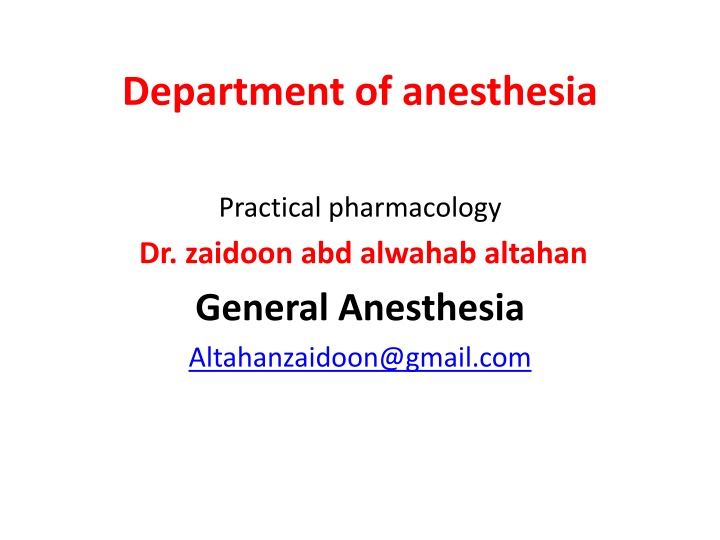
Practical Pharmacology of General Anesthesia Stages and Inhalation Anesthetics
Gain insights into the stages of general anesthesia - induction, maintenance, and recovery - along with the properties of popular inhalation anesthetics like isoflurane, desflurane, and sevoflurane. Understand the benefits and considerations of each type of anesthetic for safe and efficient patient care.
Download Presentation

Please find below an Image/Link to download the presentation.
The content on the website is provided AS IS for your information and personal use only. It may not be sold, licensed, or shared on other websites without obtaining consent from the author. If you encounter any issues during the download, it is possible that the publisher has removed the file from their server.
You are allowed to download the files provided on this website for personal or commercial use, subject to the condition that they are used lawfully. All files are the property of their respective owners.
The content on the website is provided AS IS for your information and personal use only. It may not be sold, licensed, or shared on other websites without obtaining consent from the author.
E N D
Presentation Transcript
Department of anesthesia Practical pharmacology Dr. zaidoon abd alwahab altahan General Anesthesia Altahanzaidoon@gmail.com
General anesthesia is a reversible state of central nervous system (CNS) depression, causing loss of response to and perception of stimuli. The state of general anesthesia can be divided into three stages: induction, maintenance, and recovery. Induction is the time from administration of a potent anesthetic to development of unconsciousness Maintenance is the sustained period of general anesthesia. Recovery starts with the discontinuation of the anesthetic and continues until the return of consciousness and protective reflexes.
INHALATION ANESTHETICS Inhaled gases are used primarily for maintenance of anesthesia after administration
Isoflurane it undergoes little metabolism, isoflurane is considered nontoxic to the liver and kidney. Its pungent odor stimulates respiratory reflexes (breath holding, salivation, coughing, laryngospasm), so it is not used for inhalation induction. less ideal for short procedures; however, its low cost makes it a good option for longer surgeries
Desflurane Desflurane provides very rapid onset and recovery due to low blood solubility. This makes it a popular anesthetic for short procedures. It has a low volatility, which require administration via a special heated vaporizer Desflurane has significant respiratory irritation like isoflurane so it should not be used for inhalation induction. Its degradation is minimal and tissue toxicity is rare. Higher cost occasionally prohibits its use.
Sevoflurane Sevoflurane has low pungency or respiratory irritation. This makes it useful for inhalation induction, especially with pediatric patients It has a rapid onset and recovery due to low blood solubility. Sevoflurane has low hepatotoxic potential may be nephrotoxic with very low fresh gas flow that allows longer chemical reaction time
Nitrous oxide Nitrous oxide ("laughing gas") is a nonirritating potent sedative that is unable to create a state of general anesthesia Nitrous oxide does not depress respiration, and maintains cardiovascular hemodynamics as well as muscular strength Nitrous oxide is poorly soluble in blood and other tissues, allowing it to move very rapidly in and out of the body.
INTRAVENOUS ANESTHETICS IV anesthetics cause rapid induction of anesthesia often occurring in 1 minute or less. It is the most common way to induce anesthesia before maintenance of anesthesia with an inhalation agent IV anesthetics may be used as single agents for short procedures or administered as infusions
Propofol is an IV sedative/hypnotic used for induction and/or maintenance of anesthesia It is widely used and has replaced thiopental as the first choice for induction
Barbiturates Thiopental is an ultra-short-acting barbiturate with high lipid solubility. It is a potent anesthetic but a weak analgesic
Benzodiazepines Benzodiazepines The benzodiazepines are used in conjunction with anesthetics for sedation and amnesia. The most commonly used is; midazolam Diazepam lorazepam






















